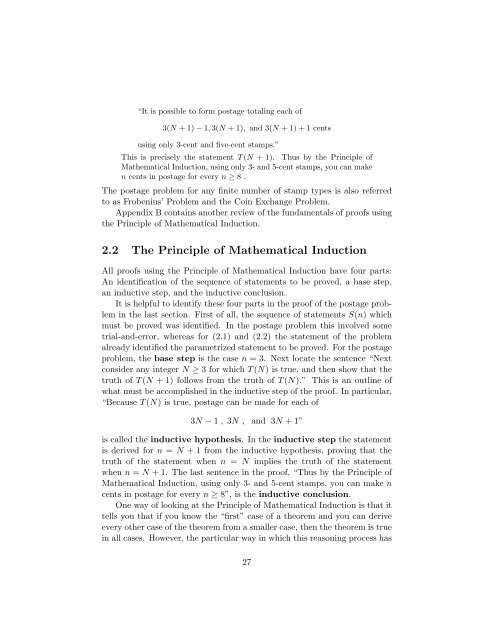DISCRETE MATHEMATICS THROUGH GUIDED DISCOVERY ...
DISCRETE MATHEMATICS THROUGH GUIDED DISCOVERY ...
DISCRETE MATHEMATICS THROUGH GUIDED DISCOVERY ...
You also want an ePaper? Increase the reach of your titles
YUMPU automatically turns print PDFs into web optimized ePapers that Google loves.
“It is possible to form postage totaling each of<br />
3(N + 1) − 1, 3(N + 1), and 3(N + 1) + 1 cents<br />
using only 3-cent and five-cent stamps.”<br />
This is precisely the statement T (N + 1). Thus by the Principle of<br />
Mathematical Induction, using only 3- and 5-cent stamps, you can make<br />
n cents in postage for every n ≥ 8 .<br />
The postage problem for any finite number of stamp types is also referred<br />
to as Frobenius’ Problem and the Coin Exchange Problem.<br />
Appendix B contains another review of the fundamentals of proofs using<br />
the Principle of Mathematical Induction.<br />
2.2 The Principle of Mathematical Induction<br />
All proofs using the Principle of Mathematical Induction have four parts:<br />
An identification of the sequence of statements to be proved, a base step,<br />
an inductive step, and the inductive conclusion.<br />
It is helpful to identify these four parts in the proof of the postage problem<br />
in the last section. First of all, the sequence of statements S(n) which<br />
must be proved was identified. In the postage problem this involved some<br />
trial-and-error, whereas for (2.1) and (2.2) the statement of the problem<br />
already identified the parametrized statement to be proved. For the postage<br />
problem, the base step is the case n = 3. Next locate the sentence “Next<br />
consider any integer N ≥ 3 for which T (N) is true, and then show that the<br />
truth of T (N + 1) follows from the truth of T (N).” This is an outline of<br />
what must be accomplished in the inductive step of the proof. In particular,<br />
“Because T (N) is true, postage can be made for each of<br />
3N − 1 , 3N , and 3N + 1”<br />
is called the inductive hypothesis. In the inductive step the statement<br />
is derived for n = N + 1 from the inductive hypothesis, proving that the<br />
truth of the statement when n = N implies the truth of the statement<br />
when n = N + 1. The last sentence in the proof, “Thus by the Principle of<br />
Mathematical Induction, using only 3- and 5-cent stamps, you can make n<br />
cents in postage for every n ≥ 8”, is the inductive conclusion.<br />
One way of looking at the Principle of Mathematical Induction is that it<br />
tells you that if you know the “first” case of a theorem and you can derive<br />
every other case of the theorem from a smaller case, then the theorem is true<br />
in all cases. However, the particular way in which this reasoning process has<br />
27

















